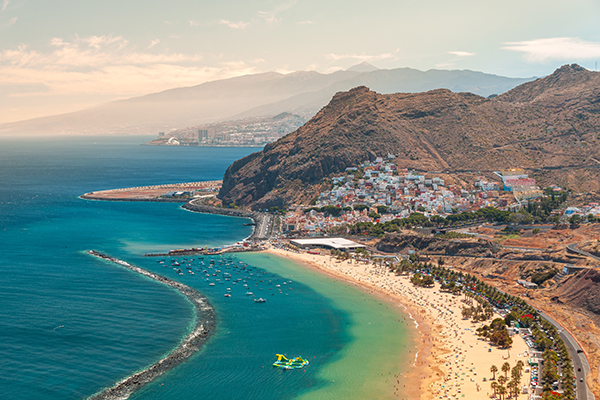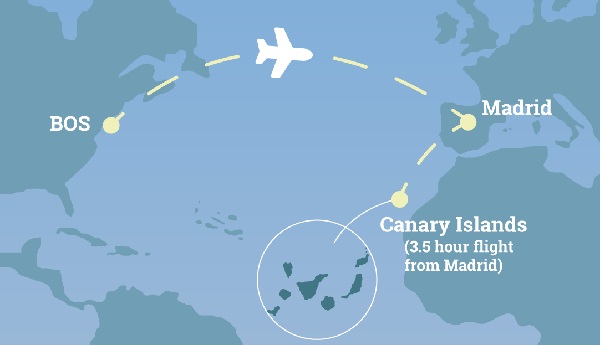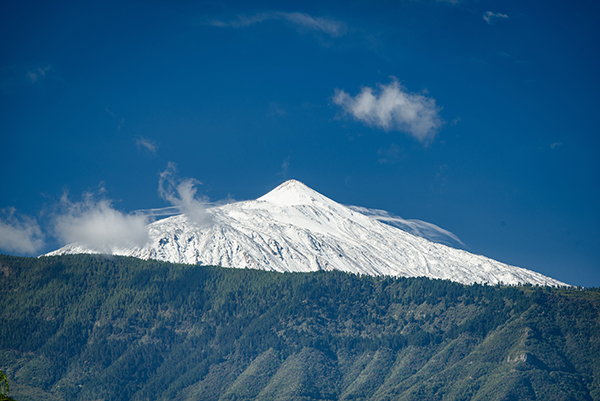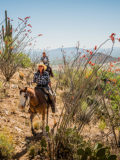
Famous beach, Playa de las Teresitas. Photo: Adam Niescioruk, Unsplash
Although many people have heard of the Canary Islands, few have heard of the island of Tenerife, “The island of eternal spring.” So, what is so special about Tenerife? Where is it? How do you get there?
Here’s all you need to know about traveling to Tenerife.

Map of Canary Islands
Where Are the Canary Islands and Tenerife?
Tenerife is the largest of the Canary Islands, a chain of Spanish islands in the eastern Atlantic Ocean off the coast of northwestern Africa. Tenerife is the largest of the archipelago, located west of Gran Canaria—the capital island.
Not your typical island destination, Tenerife has something for everyone. It’s a place where you can picture yourself in multiple places around the globe, without even stepping off the island.
Picture this: the volcanic landscapes, boardwalks, and resorts of Maui, combined with the food, wine, port, and Spanish colonial architecture of Barcelona and the white-black sand beaches of Costa Rica—all on one island.
How Do You Get to Tenerife?
Tenerife is the only island in the Canary Islands with two airports, one in the north and the other in the south. It’s also easily accessed by boat because of its two seaports.
First stop is Madrid. Once in Madrid, Tenerife is a two-and-a-half-hour flight south. Iberia Airlines also has frequent flights from all major Spanish cities, including multiple flights per day into Tenerife North Airport, the northern airport. Right now, you can get cheap flights to Tenerife for travel to the island in March on WOW Air for less than $500.
Once you’re on the island, getting around is simple. Whether you choose to take a bus, car, or taxi, the roads are well-kept, and four-lane highways are well-lit and marked with signage, allowing for easy travel.

Mount Tiede. Photo: Michal Mmozek, Unsplash
The Geography of the South and the North
The island has the highest peak in Spain: Mount Teide. This volcano divides the island into two, the cultural north and the bustling south. Did you know that Tenerife boasts nearly 250 miles of coastline and 43 miles of white sand and black sand beaches?
In the lush and tropical north end of the island, you will find Spanish colonial cities such as the United Nations Educational, Scientific, and Cultural Organization (UNESCO) world heritage city La Laguna and the old colonial port of Garachico.
A unique geological phenomenon that was caused by the last eruption in the 1790s is the lava pool formations in Garachico that you can walk around and swim in. On the opposite side of the island in the south, you will be surrounded by golden sand beaches and vibrant coastal towns. Despite the distinct and exotic terrain, you can still travel from Tenerife north to Tenerife south in less than an hour.
Climate and Weather
Known as the island of eternal spring, temperatures average around 75 degrees year-round. The island’s varied topography offers a plethora of options for those seeking adventure.
From the beach to the mountains, explore banana plantation-filled valleys, marvel at lunar landscapes, hike through giant rhododendron and beautiful fern forests, or try your hand at windsurfing or paragliding.
The four separate microclimates on the island allow for a varied and diverse amount of activities and experiences. Whatever your preference, you’ll be sure to find your ideal climate here.
Things To Do in Tenerife
If you’re looking for what to do in Tenerife, there’s no shortage of activities. At 12,198 feet above sea level, there’s Teide National Park, one of Tenerife’s national treasures and a UNESCO world heritage site with some of the best stargazing in the world.
Under the sea, the crystal-clear waters of the Atlantic Ocean are filled with a rich diversity of marine life, making it a top location for whale and dolphin watching, as well being an underwater paradise for divers.
Above the water, Tenerife is home to one of the top spas in Europe, the unparalleled waterpark, and one of the best zoos in the world.
Anaga Forest is a UNESCO Biosphere Reserve that is popular with hikers. This protected nature area is a wonderful place to see birds, reptiles and animals of all kinds.
For you foodies and wine connoisseurs, you’ll want to visit Tenerife’s world-famous vineyards and taste some traditional meals such as papas arrugadas con mojos. For those who are more adventurous, Tenerife is full of unique activities, such as exploring the 10-mile-long Cueva del Viento—the “Cave of Wind” at Icod de los Vinos, the longest lava tube in Europe.
More to Do in The Canary Islands
You can try your hand at diving, exploring and luxuriating on the black and white sand beaches, birdwatching, stargazing, testing out the waterpark and the many Michelin-Starred restaurants.
 Travel Planning Resource
Travel Planning Resource
Quest Travel Adventures is a small tour operator specializing in travel to the Atlantic islands: the Azores, Portugal, and the Spanish Canary Islands.
Planning a trip? Check out Quest Travel Adventures Itinerary, “8 Day Royal Madrid and the Canary Islands” package.














